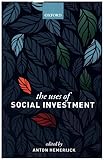The uses of social investment / edited by Anton Hemerijck.
Publisher: Oxford : Oxford University Press, 2017Edition: First editionDescription: xxiii, 475 pages : illustrations ; 24 cmContent type:- text
- unmediated
- volume
- 019879049X
- 9780198790495
- 9780198790488
- 0198790481
- 332.6 HEM
- HG4515.13 .U83 2017
- MF 9200
| Item type | Current library | Shelving location | Call number | Status | Date due | Barcode |
|---|---|---|---|---|---|---|
 BOOKs
BOOKs
|
National Law School | MPP Section | 332.6 HEM (Browse shelf(Opens below)) | Available | 36529 |
Browsing National Law School shelves, Shelving location: MPP Section Close shelf browser (Hides shelf browser)
Includes bibliographical references (pages 413-460) and index.
Part 1: Introduction
1:Social Investment and its Critics, Anton Hemerijck
Part 2: Limits to Social Investment
2:Social Investment: the Thin Line Between Evidence Based Research and Political Advocacy, Brian Nolan
3:'Social Investment': With or Against Social Protection?, Jean-Claude Barbier
4:Family Relationships and Gender Equality in the Social Investment Discourse: A Too Reduced View?, Chiara Saraceno
5:Social Investment and the Matthew Effect: Limits to a Strategy, Giuliano Bonoli, Bea Cantillon, and Wim Van Lancker
6:The 'New Welfare State' Under Fiscal Strain: Austerity Gridlocks and the Privatization of Risk, Daniel Mertens
Part 3: Social Investment Endowment and Extensions
7:Enabling Social Policy, Lane Kenworthy
8:Social Investment and the Service Economy Trilemma, Anne Wren
9:Towards Employment Insurance?, Günther Schmid
10:Social Investment and Childcare Expansion: A Perfect Match?, Margarita León
11:Addressing Human Capital Risks and the Role of Institutional Complementarities, Verena Dräbing and Moira Nelson
12:Capacitating Services and the Bottom-Up Approach to Social Investment, Charles Sabel, Jonathan Zeitlin, and Sigrid Quack
13:A Normative Foundation for the Social Investment Approach?, Nathalie Morel and Joakim Palme
Part 4: Social Investment Assessment: Conceptualization and Methods
14:Practical Pluralism in the Empirical Study of Social Investment: Examples from Active Labor Market Policy, Brian Burgoon
15:Social Investment and its Discount Rate, Iain Begg
16:Conceptualising and Measuring Social Investment, Johan De Deken
17:Measuring Social Investment Returns: Do Publicly Provided Services Enhance Social Inclusion?, Gerlinde Verbist
Part 5: Comparative Social Investment Experience
18:Developing and Spreading a Social Investment Perspective: The World Bank and the OECD Compared, Jane Jenson
19:De-Universalization and Selective Social Investment in Scandinavia?, Kees van Kersbergen and Jonas Kraft
20:The Truncated German Social Investment Turn, Martin Seeleib-Kaiser
21:The Impact of Social Investment Reforms on Income and Activation in the Netherlands, Menno Soentken, Franca van Hooren and Deborah Rice
22:Ireland: the Evolving Tensions Between Austerity, Welfare Expansion and Targeted Social Investment, Rory O'Donnell and Damian Thomas
23:Social Investment in a Federal Welfare State: The Quebec Experience, Alain Noël
24:A Social Investment Turn in East Asia? South Korea in Comparative Perspective, Timo Fleckenstein and Soohyun Christine Lee
25:Social Investment in Latin America, Johan Sandberg and Moira Nelson
26:Why No Social Investment in Italy: Timing, Austerity, and Macro-level Matthew Effects, Yuri Kazepov and Costanzo Ranci
Part 6: EU Social Investment Advocacy
27:Social Investment for a Cohesive and Competitive European Union, Evelyn Astor, Lieve Fransen, Marc Vothknecht
28:Can European Socio-Economic Governance be Social Investment Proof?, Sonja Bekker
29:Social Investment as a Policy Platform: A European Argument, Frank Vandenbroucke
30:Accelerator or Brake? The EU and the Difficult Politics of Social Investment, Maurizio Ferrera
Part 7: The Politics of Social Investment
31:The Politics of Social Investment: Policy Legacies and Class Coalitions, Silja Häusermann and Bruno Palier
32:Three Challenges for the Social Investment Strategy: Investing in the Future, Taxes, and the Millennials, John Myles
33:Public Opinion and the Politics of Social Investment, Marius R. Busemeyer
34:Social Investment, Social Democracy, Neoliberalism, and Xenophobia, Colin Crouch
Part 8: Conclusion
35:The Uses of Affordable Social Investment, Anton Hemerijck
The Uses of Social Investment provides the first study of the welfare state, under the new post-crisis austerity context and associated crisis management politics, to take stock of the limits and potential of social investment. It surveys the emergence, diffusion, limits, merits, and politics of social investment as the welfare policy paradigm for the 21st century, seen through the lens of the life-course contingencies of the competitive knowledge economy and modern family-hood. Featuring contributions from leading scholars in the field, the volume revisits the intellectual roots and normative foundations of social investment, surveys the criticisms that have leveled against the social investment perspective in theory and policy practice, and presents empirical evidence of social investment progress together with novel research methodologies for assessing socioeconomic 'rates of return' on social investment. Given the progressive, admittedly uneven, diffusion of the social investment policy priorities across the globe, the volume seeks to address the pressing political question as to whether the social investment turn is able to withstand the fiscal austerity backlash that has re-emerged in the aftermath of the global financial crisis.








There are no comments on this title.